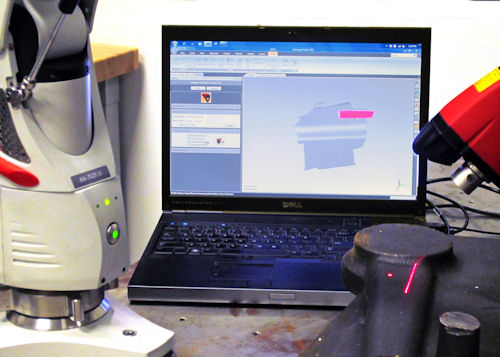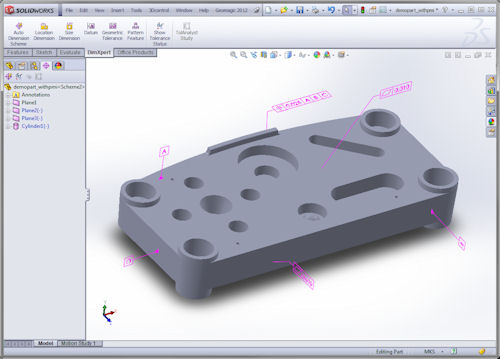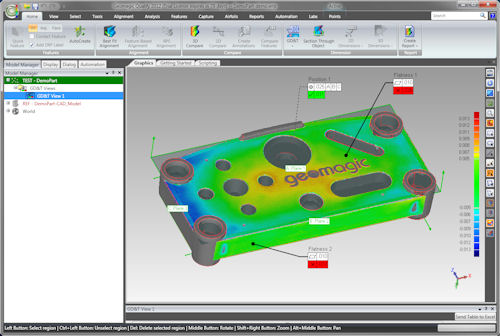Latest News
October 1, 2012
By Debbie Sniderman
Not so long ago, 3D scanning hardware systems contained proprietary hardware and software packages that made it difficult and time-consuming to integrate the scanned points with CAD software. But over the last five years, as the 3D scanning industry has matured, producers have responded to user needs “and are partnering together to improve integration with CAD packages.
DE spoke with a metrology service provider, a 3D scanning hardware vendor and a bridge software producer to find out more about the concept of seamless integration.Better Bridge Software
The majority of Exact Metrology’s service business is scanning parts and creating CAD models for overloaded customers. Some send 3D scan data from X-ray or computed tomography (CT) scanners, requesting CAD files. The company uses many different scanning and 3D technologies for creating models of small-scale parts “up to buildings or city blocks. |
| Exact Metrology scans a casting with a Hexagon Absolute SI arm/scanner directly into Geomagic software. |
 |
| A SolidWorks CAD model ready for export with model-based datums (MBD), product manufacturing information (PMI) or Geometric Dimensions and Tolerances (GD&T) callouts defined. |
Open Hardware for Scan-To-Design Applications
Alex Lucas, business development manager of Nikon Metrology’s Scanning Products, agrees that it is becoming easier to gather and process point cloud data for copying a part, building a descriptive database to archive, or for finite element analysis (FEA) customers who want to develop a CAD model. For workflows that start with a “clean slate,” or no model already developed in CAD, Nikon Metrology’s application programming interfaces (APIs) allow scanning hardware to accurately and reliably interface with software that can control and fully manage point cloud acquisition. They also allow parameter modification and qualification or calibration routines. |
| The inspection workflow using Nikon Metrology’s Proprietary Focus Software involves scanning a part, importing its CAD data and the scanned points, and aligning and comparing the two datasets. |
Retaining Control During Inspections
On the inspection side, Lucas says, the integration story is different. Inspection workflows involve scanning a manufactured shape and comparing that to an as-designed shape. This process also involves one or two software packages in addition to CAD. For the scanning step, Lucas says Nikon Metrology prefers that customers use Nikon’s own proprietary software, such as the stand-alone FOCUS API, for handheld inspections.“Part of the point cloud inspection process is dictated by the features and surfaces that a user wants to check,” he explains. “Our specialty is controlling the scanners and the entire inspection process, so we want to control what data goes into it by integrating with the data brought in from CAD directly, rather than allow third-party control of that data.” The next step involves software that accepts user-input scan data, stitches together a 3D model, and compares it against a definition. This could be accomplished with a manufacturer’s standalone package or third-party bridge software. Most of the time, 3D geometry or shape data provided into that software comes from a CAD model “but it’s not the complete file, and it contains limited “dumb” geometry information without feature, history or product manufacturing information (PMI).“Even though our software for inspection scanning is proprietary, our hardware provides industry-standard formats for transferring data,” Lucas says, offering discrete ASCII x, y and z data in column or .csv format, and polygonal mesh .stl files as examples. “We also output in several proprietary file formats, which may lock a user into a certain software company’s file extension.”‘Perfect Integration’
Geomagic is an example of bridge software that is used for both types of scanning applications mentioned above. Kevin Scofield, Geomagic’s senior product manager for metrology and modeling applications, says he sees requests to include more information from CAD models during inspections, such as dimensions, freeform geometry-like features, or other metadata that accompanies the geometry. |
| The GD&T callouts from the CAD model are automatically analyzed and reported after being imported. |
Improving Relationships
On the hardware side, Scofield says Geomagic has strategic relationships with more than a dozen major manufacturers of digitizers and scanners that have unlocked their hardware and released APIs to use their software. “Manufacturers often release new hardware devices and versions, so we’re constantly keeping up with their latest developments,” he says. On the CAD side, Geomagic licenses third-party CAD importing libraries that allow it to read in and offer native CAD file formats. It builds these libraries into its software. Scofield says Geomagic used to charge as much as $2,500 per CAD importer, but the company has since recognized the value it is adding and now provides them for free.“There is a lot of upkeep on this end, too, as CAD companies revise their software versions. We’re always getting and testing new libraries. Between the hardware companies and the CAD companies, there’s a lot to keep our eye on,” he says. Scofield points out that it’s rarely asked why CAD programs don’t interact directly with hardware, or why software like Geomagic can’t work inside of CAD. But he knows the answer. “Because rendering time and memory requirements are extremely high for millions of discrete points, no one cares to do it. There’s more stress handling large files and memory. It doesn’t mean that it’s not the right thing to do, but it’s a reason the big CAD companies haven’t done it.“But that is another possibility for the future,” he says. DEDebbie Sniderman is an engineer, writer and consultant in manufacturing and R&D. Contact her at VIVLLC.com.
More Info
Exact Metrology Geomagic Nikon Metrology Nikon Metrology Point Cloud Software APISubscribe to our FREE magazine, FREE email newsletters or both!
Latest News
About the Author
DE’s editors contribute news and new product announcements to Digital Engineering.
Press releases may be sent to them via [email protected].






